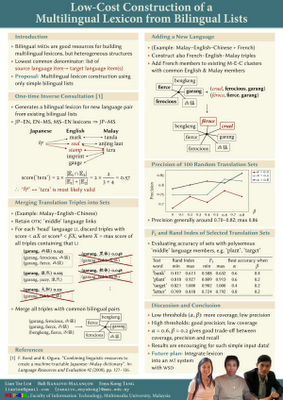I presented a poster paper at CICLing 2011 in Tokyo (that was the end of February so I wasn’t there during the earthquake, but it seems the organising committee members are all alright, thank heavens) and I naturally created my poster with LaTeX. ![]() Here’s a thumbnail of my poster:
Here’s a thumbnail of my poster:
I created this A0-sized poster (source code the TikZ drawings and CJK characters are externalised as PDF graphics and the bibliography embedded, so it should be compilable on most LaTeX installations without extra packages) with the beamerposter package, mainly by modifying Rob Hyndman’s style file. (There are other packages for creating posters in LaTeX, see this link for an overview.)
You can download my .sty and a simple sample poster .tex files here. I’ve put the colour themes (ComingClean in the left thumbnail, ConspiciousCreep on the right, inspired by this and this respectively) in their own separate .sty files. ConspiciousCreep is probably not so suitable for an academic poster… but perhaps it could be useful for a not-so-serious occasion.
Note that the sample poster is A1-sized; change the poster size in the .tex file as you require. I also defined a \footimage command that can be used to put whatever material you want in the bottom right hand corner. (I included photos of the authors in my poster not because of vanity, but because the organisers asked us to do so, so that it’d be easier for participants to locate the relevant authors.)
I brought my A0-sized PDF along to a printing shop who happily printed it out on one glorious giant A0-sized synthetic paper material. However, if you have trouble finding a printing shop who can print out these big sizes, you can use the pdfposter utility (available on all major GNU/Linux distros) to process your PDF into smaller-sized tiles. For example, if the input LLTposter-sample.pdf is A1-sized, then
pdfposter -s1 -ma4 LLTposter-sample.pdf a4tiles.pdf
will take the input file LLTposter-sample.pdf, split it into 8 A4 pages and save them in a4tiles.pdf. You can then print out the A4 pages and assemble them back into an A1-sized poster at the conference venue. (-s1 means no resizing of the original poster size, hence A1 as the result.) Enjoy!





